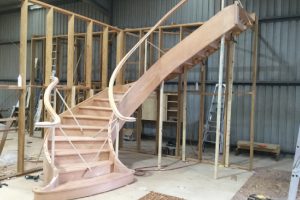Treading with care
Building a complex timber stair requires a knowledge of geometry, commitment to quality and old-fashioned hand skills. Jon Palfrey talks to a specialist.

The bespoke timber staircase industry is a very small niche market.
Sure there are plenty of businesses producing basic straight flights from MDF with steel, wire and glass balustrades, right through to architectural minimalist designs.
However, a timber staircase evokes a sense of substance unrivalled by sterile steel, glass and carpet-covered forms. The naturally beautiful textures and colours of timber bring warmth to a home.
Edward Brown Staircases has been around for more than 50 years. It specialises in bespoke curved and geometrical timber staircases of the highest quality.
The business was started by Edward Brown, originally a builder, when he was challenged by one of his clients to produce a set for a large home he was building. The business started in an old iron shed in Rouse Hill, western Sydney. The operation is now run by Edward’s son, Jeff Brown, in an 1800m2 factory in South Windsor.
Demand has waxed and waned due to fashion and economic conditions. Currently the business employs only Jeff and a first-year apprentice.
Jeff says it’s not possible to just pick up tradies with the necessary skills and experience, so he takes on an apprentice for on-the-job training. Those willing to learn must have good hand skills, an eye for detail and an understanding of geometry.
Group training schemes have been tried as a source of apprentices but mentoring local high school students in work experience has been more successful.
Jeff has also employed a mature-age apprentice who was in a Master Builders Association accelerated pathway program. The trainee’s previous career was in information technology and he was looking for a change.
The current employee is undertaking a cabinet-making apprenticeship, as this provides the detailed knowledge of woodworking and shaping required for staircase work. The carpentry (and Joinery) apprenticeship no longer covers the complex geometry of curved stairs.
As in many small businesses, relationships between the client, builder and stair maker are crucial to ensure all projects go smoothly.
There is a general misunderstanding of the space required, the time in production and the building code requirements for these stair types. So it’s important that the relationships are established early in the planning stage of a building.
The residential building boom has had an effect on the business, especially with the trend to apartment living.
In the 1980s and 1990s people were looking to build two-storey houses on small blocks at the city fringe. Today’s home buyers want to be closer to work and enjoy the convenience of city living.
Computer numerical control (CNC) machining has made inroads into the joinery industry in the past decade or so – first with flat-panel machinery and more recently with three-axis and five-axis routing technology that allows complex shaping of large timber sections.
Jeff can see the benefits of the technology, but there’s insufficient demand to justify the expense. He says some manufacturers are using the basic technology for less sophisticated processes such as straight flights, winders and spirals.
Architects are sourcing some staircases from overseas, mainly Asian countries, in an attempt to keep costs down. The problem is that builders find it difficult to get installers for these complex pieces of joinery.
In addition, lead times and transport logistics, compliance and codes, working tolerances and warranty problems make it desirable to source locally.
When it comes to elliptical stairs, in which each tread is a different shape (then you throw in flared flight) the complexity of design and construction is best addressed with traditional hand skills and machinery.
This business still hand cuts and carves curved handrails, scrolls and wreaths. When called for, balusters can be turned using an old copying lathe. A specialist woodcarver can be called upon for ultra-complex work.
One other crucial issues for this industry is the sourcing of suitable materials.
Matching stairs to floors is problematic. Many fashionable timbers (black butt, brush box and blue gum) don’t lend themselves to bending and shaping for a geometrical set of stairs.
Large enough section sizes for strings, newel posts and taper treads are generally not available. Much of the material is now laminated.
More care has to be taken in selecting the timbers. Cutting out knots, gum veins and pockets increases the waste factor (about 30% in some cases), thereby adding time and expense to the job.
Jeff says there is little appreciation for heritage joinery these days.
“It’s going to get to the point when the skilled trades people won’t be around to do the quality work.”
He sees the bespoke stair industry fading away and is considering winding down the business.
It will be a great shame to lose the skills. Maybe it’s a clarion call to government and industry to support and foster the development of staircase building skills, which are transferable to other bespoke situations.
*This article first appeared in the summer 2018 edition of Building Connection. Click here to subrscribe.
